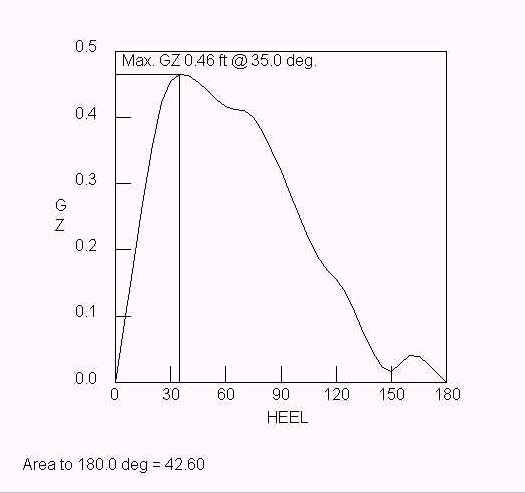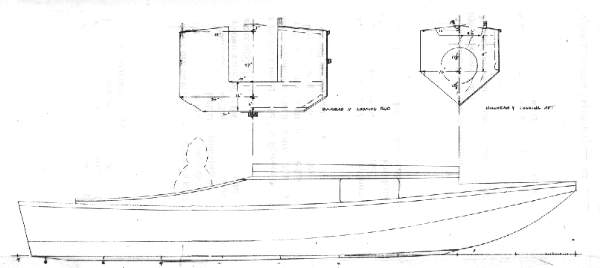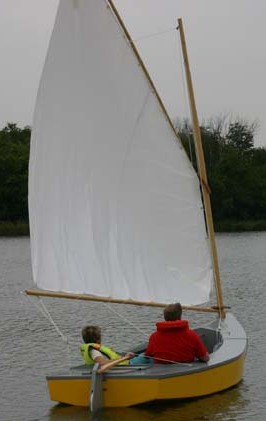
Wojtech's Polish Campjon is ready for the winter.
Contents:
Contact info:
Jim Michalak
118 E Randall,
Lebanon, IL 62254Send $1 for info on 20 boats.
Jim Michalak's Boat Designs
118 E Randall, Lebanon, IL 62254
A page of boat designs and essays.
(1dec05) This issue will start to discuss ballast calculations. The 15dec issue will continue the subject.
THE BOOK IS OUT!
BOATBUILDING FOR BEGINNERS (AND BEYOND)
is out now, written by me and edited by Garth Battista of Breakaway Books. You might find it at your bookstore. If not check it out at the....ON LINE CATALOG OF MY PLANS...
...which can now be found at Duckworks Magazine. You order with a shopping cart set up and pay with credit cards or by Paypal. Then Duckworks sends me an email about the order and then I send the plans right from me to you.

|
Left:
Wojtech's Polish Campjon is ready for the winter.
|
|
|
Ballast Calculations 1
I started a new project named Robbsboat, not to be confused with Bobsboat. I think Robb really wanted a Matt Laydon Paradox but was put off by all the detail involved and was hoping for something similar.
Messing About In Boats ran a really good and totally detailed series of about 20 articles about ten years ago about building a Paradox, right down to sewing the sail. But I don't believe that builder ever followed up with any sort of sailing report.
As I recall Laydon was a young man sailing out of Connecticutt in boats he had developed and made himself. The last, Paradox, was a heavy narrow ballasted sharpie, about 14' long, that he eventually sailed all along the east coast and out to the Bahamas for extended times (months). It is easy to get carried along by his adventures. I think by the time he made Paradox Matt was a seasoned sailor and above all else a very patient sailor. I will bet he waited in harbor for weeks perhaps waiting for the right wind to run to the Bahamas, just as Columbus and Drake did. Paradox has no leeboards or daggerboard or centerboard but instead relied on deep hard chines with "runners" which are short prominent edges at the chines. Matt's Paradox was quite heavy when loaded up, about 1400 pounds as I recall. So it sank deeper than you might expect and had a lot more hull in the water.
My own feeling is that Paradox is not well suited to the usual sailor who will not be going far, will need to do a lot of quick maneuvers, and will be sailing for only a few hours. I also think that many people have no concept of "cruising" in a boat that has the volume of a typical jonboat. But then again few people cruise in their cruisers. I can't help but feel that the fellow who wrote the great building series took his Paradox out and found it was cramped and did not handle well on the usual confined lake. But I could be very wrong about all of this.
Anyway, Robb wanted a version of it and I decided to give it a try. He specified a plumb sided sharpie shape with the top cabin built into the sides like a Birdwatcher, but Robb did not want the Birdwatcher slot, just the normal sliding hatch.
Here is a picture of the Hullforms model we came up with:

It is 15' long, 4' wide and 3.5' deep. More or less the same size as my AF3 but has no open cockpit. It is totally decked over and you are supposed to sail it from the inside. Robb specified very rugged construction, 1/2" plywood all around, and a total weight of at least 1500 pounds which is at least twice what a typical lake trailer sailer of that size would weigh.
So this is the boat we are going to ballast in hopes of making it self righting............
SO WHAT IS SELF RIGHTING, ANYWAY????
Man, is that a question to start arguments. I think Howard Chapelle said once that if a sharpie can right itself from a 45 degree heel it is self righting. But I can assure you that ain't enough for most of us. My experience is that when a boat heels over to say 60 degrees the sail's power gets spilled and it doesn't want to go anymore. Very often I try to ballast a boat so it can go full sideways on the water, 90 degrees of heel, and pop up again on its own. I think that is good enough for lake sailing where you have a chance of rescue and where waves won't be huge. The ocean is a different matter since you can be rolled by waves alone, no wind involved. (Actually on a large open lake you can get say 3' waves pretty often, enough to roll a small boat over.) I think "self righting" to an ocean sailor is more like 140 degrees of heel. We will take a look at what is needed to get these sorts of self righting using Hullforms.
Hullforms is a great little program. I have no idea of how it works but I have never caught it telling me a lie. It does not take any sort of processing power and any sort of machine will run it quickly. You can download demos of it for free using the link at the end of this webpage. The demos are more than sufficient to solve this problem as you will see.
Hullforms asks for all the info anyone will need to solve this sort of problem. It is not a design program - you will need to design your hull first. Then you will put hull measurements into Hullforms sufficient to define your hull. It will go quickly once you get the hang of it.
To solve the hydro problems Hullforms will ask you for the weight of the boat and where the center of gravity is. The weight for Robbsboat was given to me by Robb as at least 1500 pounds, so when we set up the Robbsboat lines we gave it enough bottom rocker to keep the bow tip and the transom out of the water at that weight. Then I guessed at the "X" location of the cg (fore and aft trim) until the program showed me the hull was trimmed level. Like this:

It turns out that Robbsboat floated level with the cg 8' aft of the bow as shown.
Now the problem to solve is to find the Z location of the center of gravity that will allow self righting. To start we will take a guess at z=1.75' which is halfway up the cabin. Plug that info into the Hullforms questionaire and it gives us this righting moment curve for that weight and cg location:

The machine is telling us that the boat will self right up to 66 degrees, beyond that the righting moment goes negative and she will flop on her side or beyond. Might be good enough for safe sheltered sailing but we are looking for more.
Let's move the cg down to 1.5' and see the curve:

Now we should self right out to 110 degrees and that should be good. Once you get to high angles of heel you need to check to see if your hatches are going under.
The chart tells us a lot more information. The number gz is the "righting arm". You can think of the righting moment as a torque determined by the weight times the righting arm. So in this case it would be 1500 pounds times .35' = 525 ft-lbs. It is also telling us the maximum righting moment is at 30 degrees of heel. That would also be the point where you could carry the maximum sail. The area under the curve to capsize is also given. I've forgotten exactly what that means but I think it might be looked upon as the "power" of the boat to self right.
Hullforms makes these charts in a second or two. Might as well run another at cgz=1.4':

Now we are good out to 136 degrees and note that even then the curve goes negative for only a short while. If it rolls all the way to 180 degrees the curve goes positive. So here the boat has just a narrow range of negative stability.
Might as well go one more step to cgz = 1.3':

Now it is all positive. The boat should self right from anything if you can keep the water out of the hatches.
Well, now we have a good starting point. In an hour's time Hullforms has solved difficult problems that would take weeks by hand. Usually this sort of work was never done even for boats a lot larger than this back in the days of hand calculations. They used rules of thumb and testing. Even with computers doing the numbers it is a very good idea to test.
Next issue we will use these cg numbers to figure how much ballast will be needed and where it needs to be placed.
Dorado

DORADO, POWER CUDDY SKIFF, 18' X 5.5', 650 POUNDS EMPTY
Dorado is a Southern Hemisphere constellation and also this boat designed for Ashley Cook in New South Wales. The idea behind it was for a rough water power boat with a sleepable cuddy cabin. We started with my Frolic2 sailboat (which itself evolved from the Toto canoe) and straightened out the stern lines to adapt it for planing power. After mocking it up Ashley said he and family needed another 3" of headroom so Dorado B was born and built. The plans show it both ways. I should add that even though Dorado started out as a modified sailing hull, it probably would be a terrible sailer just as Frolic2 would be a terrible power boat on plane. The two worlds just don't mix and the idea of "just hoisting a simple sail" on Dorado is bound to be a sure loser both because it will sail poorly and because you will lose the simplicity of a straight power boat. Not that the idea isn't worth more study. It would take a special person to do all the tweaking involved with making the two-way boat work well.

The shape works! Ashley has been running DoradoB into the rough stuff. In the above photo he is off the east coast of Australia with nothing but ocean between him and New Zealand. He says the big curling wave to his side is a permanent fixture and fatal to boaters trying it. This sort of water is the real advantage of a bottom shape more complex that simple flat bottom, of course. A flat bottomed boat like AF4 would get beaten up badly and be clumsey in such waters. Also the more complex bottom handles better all around, especially in tight turns, than the flattie and that is why the Coast Guard will give a horse power allowable rating quite a bit higher to such a boat when compared to the flattie. The flattie has the advantage of a lot more floor space, less draft, simpler construction, and faster speed in smooth water - so flatties live on. (Ashley sent me a video of Dorado doing sharp full throttle turns, something I would never do in AF4.)
He is using a new 30 hp two stroke motor. The Coast Guard would say that is the max for this hull. With the 30 Ashley reports cruising at about 20 mph with two adults on board. As an aside I should mention that in boats like this one needs to pay attention to the prop specs to prevent the motor from going over redline at full throttle. If the usual prop is for a heavier and slower boat then I would expect the motor to rev too high at full throttle in a lighter faster boat. The idea is to select a prop with a pitch that will put the tach on the red line at full throttle.

The hull is made with taped seams needing two sheets of 1/2" plywood and eight sheets of 3/8" plywood, a total of about 400 pounds of wood. I would expect the stripped hull to weigh about 500 pounds with framing and fiberglass. I would add at least 150 pounds to that for a motor and its gear which is why I estimate the empty weight to be about 650 pounds. Add two adults and fuel and now you are around 1100 pounds total. The old rule for motors on planing powerboats is a horse for each 50 pounds so if you havea 25 horse motor you will be able to cruise this boat at 2/3 throttle. I would say 15 hp is the minimum you might use and expect to plane, even then you must stay very light and run near full throttle.

Plans for Dorado are $40 when ordered directly from me. You can also get them through www.duckworksmagazine.com.
Prototype News
Some of you may know that in addition to the one buck catalog which now contains 20 "done" boats, I offer another catalog of 20 unbuilt prototypes. The buck catalog has on its last page a list and brief description of the boats currently in the Catalog of Prototypes. That catalog also contains some articles that I wrote for Messing About In Boats and Boatbuilder magazines. The Catalog of Prototypes costs $3. The both together amount to 50 pages for $4, an offer you may have seen in Woodenboat ads. Payment must be in US funds. The banks here won't accept anything else. (I've got a little stash of foreign currency that I can admire but not spend.) I'm way too small for credit cards.
The out West Picara is I am told done to the point of using it as a powerboat:

The down South Picara is more or less complete now. Should have an updated photo soon.

This long and lean project is a 19' version of Toon2. Shown here on its first sail in very light winds. We will wait a bit longer to get a sailing report in stronger winds.

A Vector builder is keeping a website of the project at http://www.geocities.com/michsand@sbcglobal.net/ and here is a photo of his boat on its first sail, just before the storm hit. I also have photos of a Vector completed by Pete Mohylsky in Florida. Hopefully a report soon:

Here is a Musicbox2 I heard about through the grapevine.

We have a Philsboat going together in California:

AN INDEX OF PAST ISSUES
Hullforms Download (archived copy)
Plyboats Demo Download (archived copy)
Brokeboats (archived copy)
Brian builds Roar2 (archived copy)
Herb builds AF3 (archived copy)
Herb builds RB42 (archived copy)